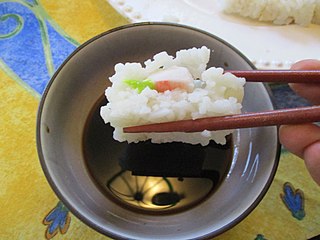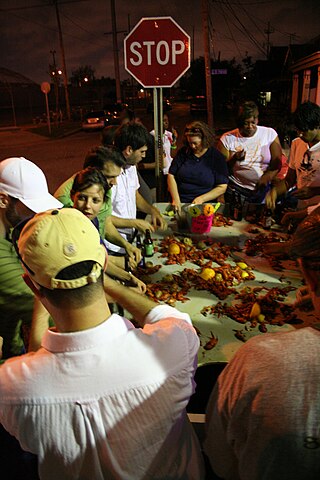
Cantonese or Guangdong cuisine, also known as Yue cuisine, is the cuisine of Cantonese people, associated with the Guangdong province of China, particularly the provincial capital Guangzhou, and the surrounding regions in the Pearl River Delta including Hong Kong and Macau. Strictly speaking, Cantonese cuisine is the cuisine of Guangzhou or of Cantonese speakers, but it often includes the cooking styles of all the speakers of Yue Chinese languages in Guangdong.

Cajun cuisine is a subset of Louisiana cooking developed by the Cajuns, itself a Louisianan development incorporating elements of Native American, West African, French, and Spanish cuisine.

Louisiana Creole cuisine is a style of cooking originating in Louisiana, United States, which blends West African, French, Spanish, and Native American influences, as well as influences from the general cuisine of the Southern United States.

Malay cuisine is the traditional food of the ethnic Malays of Southeast Asia, residing in modern-day Malaysia, Indonesia, Singapore, Brunei, Southern Thailand and the Philippines as well as Cocos Islands, Christmas Island, Sri Lanka and South Africa.

Fried rice is a dish of cooked rice that has been stir-fried in a wok or a frying pan and is usually mixed with other ingredients such as eggs, vegetables, seafood, or meat. It is often eaten by itself or as an accompaniment to another dish. Fried rice is a popular component of East Asian, Southeast Asian and certain South Asian cuisines, as well as a staple national dish of Indonesia. As a homemade dish, fried rice is typically made with ingredients left over from other dishes, leading to countless variations. Fried rice first developed during the Sui dynasty in China.

Rémoulade is a cold sauce. Although similar to tartar sauce, it is often more yellowish, sometimes flavored with curry, and often contains chopped pickles or piccalilli. It can also contain horseradish, paprika, anchovies, capers and a host of other items.

A dip or dip sauce is a common condiment for many types of food. Dips are used to add flavor or texture to a food, such as pita bread, dumplings, crackers, chopped raw vegetables, fruits, seafood, cubed pieces of meat and cheese, potato chips, tortilla chips, falafel, and sometimes even whole sandwiches in the case of jus. Unlike other sauces, instead of applying the sauce to the food, the food is typically placed or dipped into the sauce.
Norwegian cuisine in its traditional form is based largely on the raw materials readily available in Norway. It differs in many respects from continental cuisine with a stronger focus on game and fish. Many of the traditional dishes are the result of using conserved materials because of the long winters.

Seafood boil in the United States is the generic term for any number of types of social events in which shellfish, whether saltwater or freshwater, is the central element. Regional variations dictate the kinds of seafood, the accompaniments and side dishes, and the preparation techniques. In some cases, a boil may be sponsored by a community organization as a fund-raiser or a mixer. In this way, seafood boils are like a fish fry, barbecue, or church potluck supper. Boils are also held by individuals for their friends and family for a weekend get-together and on the holidays of Memorial Day and Independence Day. While boils and bakes are traditionally associated with coastal regions of the United States, there are exceptions.

Scottish cuisine encompasses the cooking styles, traditions and recipes associated with Scotland. It has distinctive attributes and recipes of its own, but also shares much with other British and wider European cuisine as a result of local, regional, and continental influences — both ancient and modern.

Deviled crab is a crab meat croquette. Deviled crab croquettes originated in Tampa, Florida, where they were developed in the Spanish, Cuban and Italian immigrant community of Ybor City. It is typically served for lunch or as a snack, and it is meant to be eaten with one hand.

Crab meat or crab marrow is the meat found within a crab, or more specifically in the leg of a crab. It is used in many cuisines around the world for its soft, delicate and sweet flavor. Crab meat is low in fat and provides approximately 340 kilojoules (82 kcal) of food energy per 85-gram (3 oz) serving. Brown crab, blue crabs, blue swimming crabs, and red swimming crabs are among the most commercially available species of crabmeat globally.

Neapolitan cuisine has ancient historical roots that date back to the Greco-Roman period, which was enriched over the centuries by the influence of the different cultures that controlled Naples and its kingdoms, such as that of Aragon and France.

Venetian cuisine, from the city of Venice, Italy, or more widely from the region of Veneto, has a centuries-long history and differs significantly from other cuisines of northern Italy, and of neighbouring Austria and of Slavic countries, despite sharing some commonalities.

Hot pot or hotpot, also known as steamboat, is a dish of soup/stock kept simmering in a pot by a heat source on the table, accompanied by an array of raw meats, vegetables and soy-based foods which diners quickly cook by dip-boiling in the broth.

Mala xiang guo, roughly translated into English as "spicy stir-fry hot pot", is a Chinese dish prepared by stir-frying. Strongly flavored with mala, it often contains meat and vegetables, and has a salty and spicy taste. The preparation process involves placing the required ingredients in the pot, stir-frying and adding seasoning. In restaurants, customers usually choose the ingredients by themselves before the chef prepares the dish.














